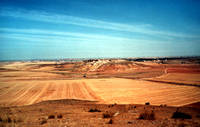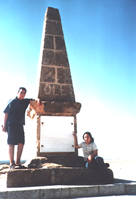 |
 |
 |
Touring the Peninsula With MattSalamanca
Book
Hotels in Spain
When I say massive, it really is. The entire battlefield is almost 5 miles (8km) across, and about 3 miles (5km) wide, and the 2 imposing 'Arapiles' are massive, steep-faced ridges with steep sided slopes covered with shingle and rocks. After turning off the N360, which lead out of Salamanca in the direction of the battlefield, the seemingly endless scorched plains lay out ahead, scattered with rocks, which made the landscape look like sandpaper. After turning off the worn, dusty tarmac road we turned on to an even dustier-looking dirt track spattered with rocks and shingle, and with the two huge Arapiles hills towering to our left and right.
As we drove carefully down this humble dirt track that immediately dissected the battlefield, it was hard to imagine the scale of the battle fought. The Arapiles were huge, but they only served as a single area of the battlefield, and with the front over 5 miles across, Wellington must truly have been a great general if he new how to coordinate men over such a wide radius. These were my thoughts as we followed the road around the back of the Greater Arapiles, and parked on an even smaller (and dustier!) dirt track that spiralled up to the top of it. We parked, and climbed towards the top, the view of the entire battlefield becoming much clearer the higher you were raised above ground level, until finally (after a race to the top between me, Derek, Sara, and Judith) we ascended the summit, and stared literally in awe at the vast expanse of the battlefield. I gazed northwards, and could just about imagine the assembled troops of Wellington's army about a half mile away, facing towards me, with a handful of shining bronze cannons glinting on top of the lesser Arapiles, and Wellington, on horseback, staring back, surrounded by his ADCs. We were standing where the French army was ''assembled'' I say this because they were not entirely ready for battle. Wellington and Marmont had been trying to outmanoeuvre each other for weeks previous, with the French trying to get around Wellingtons right (southern) flank with the allies cutting corners to prevent him. However Wellington had held a slight advantage by being in the centre of a ''circle'' (Salamanca), whilst the French army were moving around its ''circumference''. However, this slight advantage was countermanded by the French, who levelled the playing field by having the ability to march 12 miles a day compared to the allied 10. These two sides marched inexplicably for 100s of miles during these weeks, endlessly trying to gain a strategic benefit, often within cannon range of each other, and sometimes parallel to each other! The manoeuvrings came to an end as the French crossed the great bend in the Tormes as they headed southwest, hoping to threaten allied communications with Ciudad Rodrigo. Wellington, who was prepared to abandon Salamanca to safeguard the lifeline of Ciudad Rodrigo, had already sent his baggage train westwards, ready to retreat into Portugal. The battle began by skirmishing between the French and the British. This involved a scramble by 7th Cacadores and the 4th Division to get control of the Greater Arapiles, however Marmont beat back both Divisions, and gained the higher and larger hill. You can only imagine the hell it must have been for the advancing Portuguese and British to ascend this great hill, in all their gear and with their muskets under heavy fire. Wellington quickly occupied the Lesser, and started to position a few cannons on his hill. Both Arapiles acted as excellent gun-platforms, and Marmont held a clear advantage with the larger hill, sending cursing and sweating gunners up with Napoleon's ''daughters'' (his cannons) to the top of this Greater Arapiles. The rest of the morning was spent by the armies adjusting their positions, with the French continuing their march south-westwards, and the Allies matching each move. The British 3rd Division were a part of this manoeuvring, stretched far across in a 2-mile column from Santa Marta, through Carbadjos, and heading for Aldea Tejada. Wellington spent much of the morning gazing towards Marmont's marching 40,000 men, but as the sun started to beat down he retired to the farm where he divulged in some lunch. Whilst eating he turned towards the enemy, took a long look, and exclaimed: ''By God! That will do!'' and rode up the slippery slope of the Lesser Arapiles for a better viewpoint. What Wellington was so excited about was the fact that the French were advancing, and as they did so they extended their left, and began to open a gap between their left and centre. Marmont had inadvertently swung the battle in Wellington's favour, and by doing this had stretched his line so thinly that Wellington's large concentrated force were in the pivot of his advance, and so had the huge strategic advantage of being able to strike at any point in his line with a large force without weakening themselves. Wellington immediately ordered a general advance of the 3rd Division, under the leadership of Sir Edward (Ned) Pakenham, telling him: ''Ned, move on with the 3rd Division; take the heights on your front; and drive everything before you.'' To these short but clear instructions, Pakenham responded: ''I will, my lord, if you will give me your hand.'' The two gravely shook hands. So began the battle of Salamanca. From our viewpoint over the valley from the top of what was Marmont's Greater Arapiles, we could not really see where Pakenham's 3rd Division crashed into, and routed, Thomière's division, however, we knew it was to our left, and it was not hard to imagine an entire division, 7 battalions, or around 2800 men, marching across this now barren plain that was previously cornfields. One hour after the meeting with Wellington, Pakenham's 3rd division smashed into the head of Thomière's division, sending his men routing from the field, and winning the battle in minutes. However, a brave but vain counter-attack by Clausel in the centre, pushed back the 4th division for a while, but Wellington had clearly won one of his greatest, and (I think) one of the greatest battles in history. Marmont had being fatally caught off key and, by 7pm, he had fallen back towards the Alba de Tormes Bridge, having suffered 6000 casualties, lost 6000 men as prisoners, and suffering the loss of 3 and the wounding of 3 generals. On the other hand the British army gained 11 Guns, 2 Eagles, and 6 standards to name a few of their trophies. It was an incredibly brief, but chaotic, battle. A French general later commented that Wellington ''defeated 40,000 men in 40 minutes.'' This was an exaggeration, but was not far off the truth. Having being filled with awe over the massive battlefield, we clambered down considerably less burdened than the Portuguese infantry, towards the car, and headed off down the dusty dirt track towards Segovia. - Matt Mahabadi |
||||||||
|
Napoleon
Bonaparte
|
|
| Career | Portraits |
| Quotes | Family |
| Loves | Letters |
| Plots | Murdered? |
| His will | Places |
|
Era
of Napoleon
|
|
| Powers | Opponents |
| Coalitions | Allies |
| People | Timelines |
| Key sites | Shrapnel |
|
Warfare
|
|
| Campaigns | Battles |
| Armies | Generals |
| Marshals | Winners |
| Glossary | Medical |
| Weapons | 1812 War |
| Uniforms | Battlefields |
|
War
at Sea
|
|
| Naval War | Heroes |
| Artworks | Signals |
| Nelson | Trafalgar |
|
Maps
|
|
| Key Maps | Peninsula |
| Animated | 1796/1800 |
| 1809 | Russia |
|
French
Revolution
|
|
| Revolution | Guillotine |
| Posters | People |
|
Art,
Film, Games
|
|
| Education | Goya |
| Sharpe | Hornblower |
| Books | Movies |
| DVDs | Music |
| Wargames | Images |
| Cartoons | Caricatures |
|
Other
|
|
| About Us | Sources |
| Awards | Sitemap |
| Links | Militaria |
| Miniatures | Reenactors |
| Forum | Quizzes |
| Home | Waterloo Diorama |

